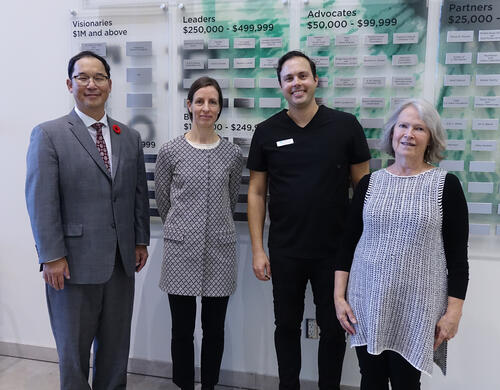
Enhancing diagnostic imaging and patient care
IRIS commits $1 million to the Waterloo Eye Institute

IRIS commits $1 million to the Waterloo Eye Institute
By Lauren Ward School of Optometry and Vision ScienceThe School of Optometry and Vision Science is celebrating a commitment of $1 million from IRIS, Canada’s most established network of optometrists, opticians and ophthalmologists.
IRIS made their pledge to enhance diagnostic imaging and improve technology for future optometrists as part of the School’s Seeing Beyond 2020 campaign. This fundraising campaign will create the Waterloo Eye Institute (WEI) – a national resource that will enrich student experiences, deliver care to remote communities and support patient health across the Waterloo region.
“I’m grateful for this commitment to the School of Optometry and Vision Science from IRIS,” says Dr. Vivek Goel, president and vice-chancellor of the University of Waterloo. “Providing advanced imaging technology will not only enhance our students’ education, but also improve patient care across our region.”

L-r: Dr. Stan Woo (Director, School of Optometry and Vision Science), Dr. Barbara Pelletier (Optometric Coordinator, IRIS), Dr. Daryan Angle (Vice President, Business Development, IRIS) and Dr. Carol Cressman, at the announcement of the IRIS pledge to School of Optometry and Vision Science Seeing Beyond 2020 campaign.
Digital imaging is a non-invasive diagnostic tool that provides a wider and more accurate way to view the eyes of patients for earlier detection of ocular disease. It is a painless way for optometrists to look inside the eye and track changes for ocular health and vision.
“We are always looking at how technology can play a role in eye care and enhance the level of service we provide for patients,” says Dr. Daryan Angle, vice president of business development and optometrist at IRIS. “Contributing specifically to the imaging lab will help bring quality care to future generations and prepare optometrists for the highest level of practice.”
This investment will equip the WEI with diagnostic imaging resources, providing opportunities for students to learn about ground-breaking technology and allowing patients to better understand their own eyes. Additional resources will include a lab with a library of images that will give students detailed knowledge of eye diseases.
“Digital imaging is an essential part of daily clinical practice now. This contribution from IRIS will allow us to ensure that we are at the forefront of innovative ophthalmic technology, enabling us to optimize and improve health outcomes for our patients,” says Dr. Nadine Furtado, professor and head of Ocular Disease and Imaging Services in the School of Optometry. “It will also give our students the opportunity to have experiential training with the latest technology and prepare the next generation of optometrists for the future of eye care.”
With improved access to care and expertise, patients in Waterloo region will have a greater ability to protect their vision and their overall health.
“On behalf of the School’s patients, clinicians and students, I’d like to thank IRIS for their extraordinary partnership,” says Dr. Stanley Woo, director of the School of Optometry & Vision Science. “With this support, the Waterloo Eye Institute will enhance clinical education and improve outcomes of patients in our local and global communities. This is a remarkable investment, and a testament to IRIS’s commitment to innovation in eye care.”

L-r: Dr. Stan Woo and Dr. Daryan Angle.

Read more
The ranking puts Waterloo's School of Optometry and Vision Science as #1 in Canada and #3 in North America

Read more
Waterloo expands its global reach in Asia through ground-breaking partnership with Hong Kong Polytechnic University

Read more
A new virtual reality (VR) training lab at the University of Waterloo’s School of Optometry and Vision Science, will help Canada’s next generation of optometrists learn how to diagnose vision problems and eye diseases more quickly and accurately
The University of Waterloo acknowledges that much of our work takes place on the traditional territory of the Neutral, Anishinaabeg, and Haudenosaunee peoples. Our main campus is situated on the Haldimand Tract, the land granted to the Six Nations that includes six miles on each side of the Grand River. Our active work toward reconciliation takes place across our campuses through research, learning, teaching, and community building, and is co-ordinated within the Office of Indigenous Relations.